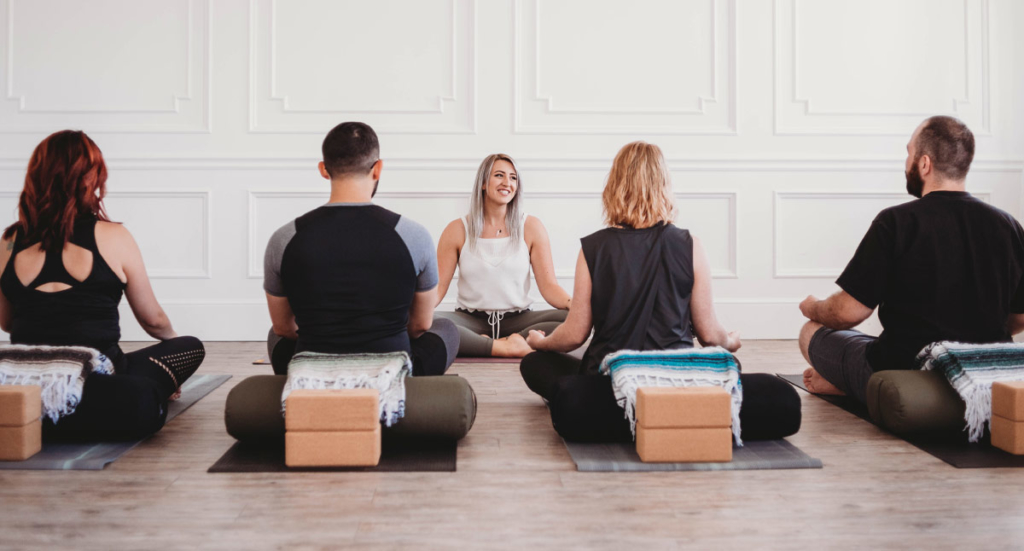This entry was posted on Feb 6, 2024 by Charlotte Bell.

My original yoga “parentage” was in the Iyengar system. Known for its precision, and for inventing the yoga props we use today, the Iyengar system provides a fine foundation. In workshops, teachers—including BKS Iyengar and his daughter, Geeta, both of whom I studied with in 1989—offered alignment cues about as fast as you could process them, and sometimes faster. As a hypermobile person, I often flopped into flexibility-focused asanas without much thought as to how I was practicing them. Iyengar-based yoga cues helped me refine my practice, so that I wasn’t simply continuing my unhealthy alignment habits.
But sometimes, when I’d attend traditional Iyengar workshops, I’d leave with an agitated nervous system. I’m guessing this is because the speed with which alignment cues were being disseminated made it difficult for me to integrate them all. There simply wasn’t time for me to process them, feel them in my body and make adjustments based on what my own body was telling me. And then there was the fact that many teachers “barked” out yoga cues, rather than sharing them. This method of teaching sometimes made me feel pressured to perform, and sometimes put me on edge.
I’ve since branched out to study with lots of other master teachers, most notably Donna Farhi and Judith Hanson Lasater. Both studied in the Iyengar system decades ago and have since forged their own paths. Both still consider healthy alignment to be important, but their ideas about alignment, and the way they communicate them, are entirely different from their Iyengar training.
Simplifying Yoga Cues
Both Donna and Judith build their classes around a few principles and allow time for individual exploration. This way of presenting information is more effective, at least for me. It’s a methodology I’ve adopted in my own teaching. This is because I believe that our own experience in our practice is ultimately our best teacher. Giving students time—and silence—to explore for themselves gives students more agency. It gives them the ability to figure out what’s best for their own bodies and minds at a given time. After all, I can’t possibly know what’s best for another person.
A Few Ideas for Simplifying Your Cues
This list is by no means exhaustive. I’m sure that people reading this will have ideas of their own that can help teachers cue more effectively. Here are a few ways that have worked for me:
- Identify an anatomical focus for your class. This can be anything—whatever is alive for you at the time. For example, you could organize a class around alignment for a particular area of the body, say, the pelvis or the shoulders. Then remind students to give attention to what they’re feeling in those areas as you progress through your sequence. Spending an entire practice on awareness of a particular area of the body gives students more time to integrate—and remember!—what they’ve learned.
- Cue students on how to move into poses, and then let them marinate in their experience. My Iyengar training taught me the importance of cueing students as they move into their asanas. I find it effective to cue alignment while they’re entering a pose. After that, I might make a few suggestions for where they might want to direct their awareness, but I also give ample time for silence while their bodies unfold into each asana.
I’d love to hear from you—teachers and students—what you find helpful in either designing or receiving yoga cues.
About Charlotte Bell
Charlotte Bell discovered yoga in 1982 and began teaching in 1986. Charlotte is the author of Mindful Yoga, Mindful Life: A Guide for Everyday Practice and Yoga for Meditators, both published by Rodmell Press. Her third book is titled Hip-Healthy Asana: The Yoga Practitioner’s Guide to Protecting the Hips and Avoiding SI Joint Pain (Shambhala Publications). She writes a monthly column for CATALYST Magazine and serves as editor for Yoga U Online. Charlotte is a founding board member for GreenTREE Yoga, a non-profit that brings yoga to underserved populations. A lifelong musician, Charlotte plays oboe and English horn in the Salt Lake Symphony and folk sextet Red Rock Rondo, whose DVD won two Emmy awards in 2010.

